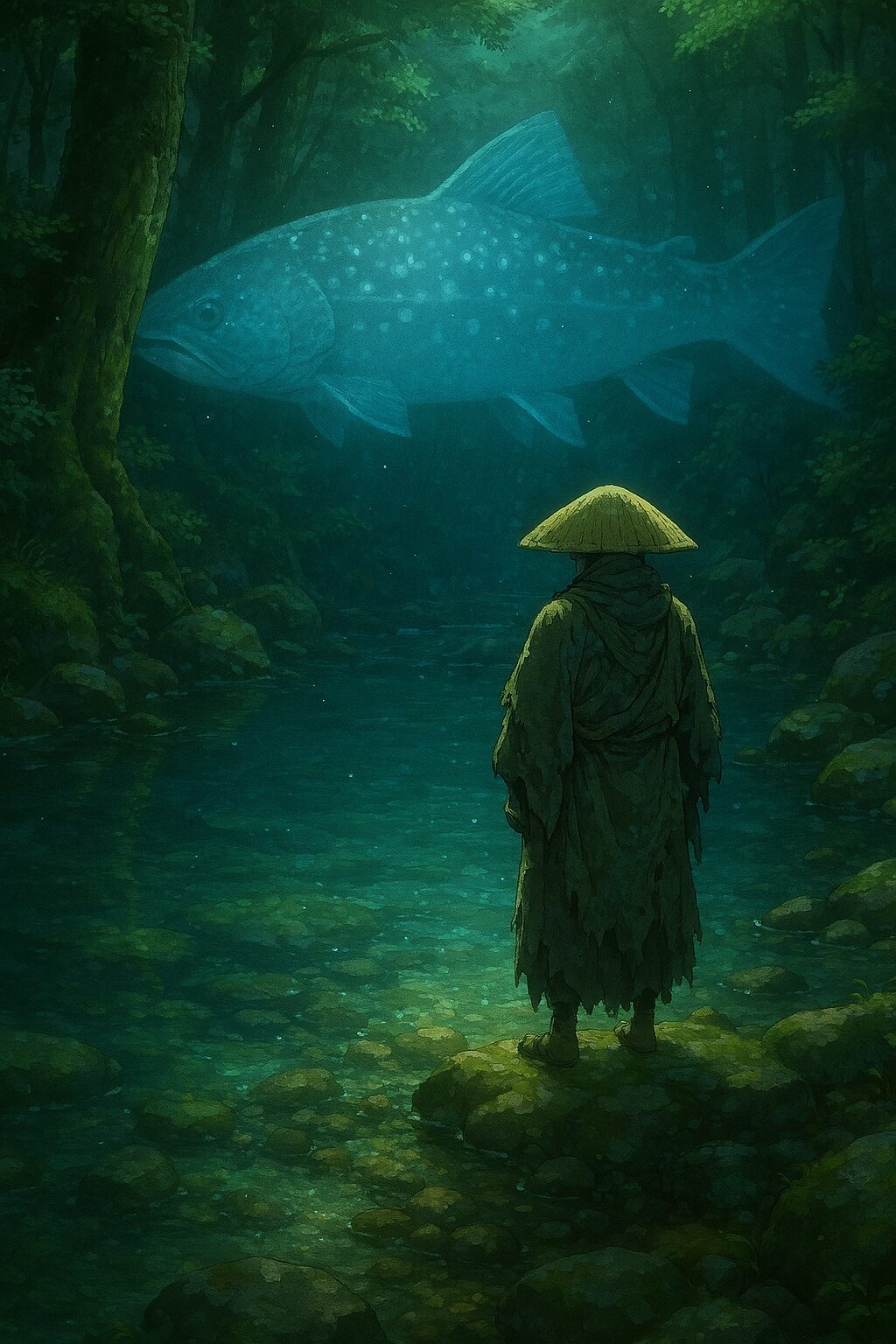Deep in the mountains of Japan, there are realms where humans are forbidden to tread. In these sacred places, beings known as “Nushi” (Masters or Guardians) have lived quietly for centuries. The story I am introducing today is “Iwana no Kai” (The Mystery of the Char / The Monster Char). This is not merely a story about defeating a monster; it is a tragic tale of the clash between human greed and the laws of nature, serving as a stern warning to those who have forgotten their awe for the wild.
1. The Story of “The Mystery of the Char”
Long ago, in a deep mountain valley, a group of four woodcutters (sometimes told as charcoal makers) ventured in to work. During their breaks, they enjoyed catching fish from the river to eat.
One day, driven by a desire to catch more fish efficiently, they decided to use a forbidden fishing method known as “Ne-nagashi” (Root-flowing). This terrifying technique involved grinding poisonous tree bark (such as Japanese pepper or walnut) and releasing the toxic juice into the river to paralyze the fish, causing them to float to the surface. It was a method that would wipe out every living creature in the stream.
The Appearance of the Mysterious Monk
Just as they finished preparing the poison and were about to pour it into the river, a shabby-looking Buddhist monk appeared out of nowhere.
“Please, stop,” the monk implored. “Do not poison the river here. You will kill all the fish. I beg of you, do not take lives so senselessly.”
The monk pleaded desperately. However, blinded by greed, the woodcutters ignored the warning.
“Shut up, you noisy priest! It’s none of your business. Get lost!”
They violently drove the monk away. After looking at them with sorrowful eyes, the monk quietly disappeared into the depths of the forest.
The Emergence of the Giant Fish
Once the monk was gone, the men immediately poured the poison into the river. The effect was instant. One by one, fish floated up, exposing their white bellies. The men cheered as they gathered their massive haul.
Suddenly, from the bottom of the river, a gigantic Iwana (Char), unlike anything they had ever seen, slowly floated to the surface. It was as large as a human, and its body glistened with an eerie black sheen.
“This is incredible! It must be the Guardian of the Valley!”
Overjoyed, the men hauled the giant fish onto the bank.
The Horrifying Conclusion
That night, they decided to prepare and eat the giant char. But the moment they sliced open its belly with a knife, they froze in terror.
What tumbled out of the fish’s stomach was not smaller fish. Instead, they found the rice ball they had thrown at the monk earlier, and a piece of the tattered robe the monk had been wearing.
“That monk… could it be…?”
They realized the truth: the monk was the Iwana itself—the Guardian of the River—who had transformed into a human to protect his kin. Knowing that his own life would be in danger, he had still come to beg the humans for mercy.
Trembling with fear, the men swore to the Mountain God that they would never again commit such senseless killing, and they fled down the mountain as if pursued by shadows.
2. Analysis: Why Did the Guardian Become a Monk?
This story deeply reflects Japanese spirituality. Why did the Iwana appear as a powerless monk rather than a terrifying monster?
- The Buddhist Teaching of Non-Killing: The monk’s form symbolizes the Buddhist precept against the taking of life (Ahimsa). The Guardian tried to appeal to their compassion rather than subduing them with force.
- The Spirit of Self-Sacrifice: The Master Iwana attempted dialogue even knowing the poison would kill him. This demonstrates a profound sense of responsibility and the aesthetic of self-sacrifice found in Japanese leadership ideals.
- Manifestation of Guilt: Perhaps the monk the woodcutters saw was a projection of their own guilty conscience, warning them that what they were doing was wrong.
3. Reading Japanese Culture: “Ne-nagashi” and Mountain Taboos
Here are key elements of Japanese culture that can be deciphered from this folktale.
Coexistence and Boundaries with Nature
Since ancient times, Japanese people have believed that spirits and gods reside in mountains and rivers (Animism). The Iwana, in particular, lives in the highest reaches of clear streams and is often called the “King of the Stream,” regarded as a sacred fish.
This story teaches that when humans disrupt the balance of nature (sustainability) through acts like poisoning the river, “retribution” (Tatari) is inevitable.
Taboos as Resource Management
“Ne-nagashi” (poison fishing) was a real historical method, but it was strictly prohibited in many regions because it killed even the juvenile fish. Instilling the fear of a curse through folktales was actually a form of wisdom to enforce sustainable resource management within the community.
4. A Question for You
In our modern world, are we prioritizing efficiency and profit to the point where we are committing “Ne-nagashi” against our environment?
If you were in the woodcutters’ shoes, would you have listened to the monk’s warning? Or would you have prioritized the immediate gain of a massive catch?
The story of the Mystery of the Char is not just an old superstition. It is a quiet, yet piercing question asking us how we should face nature today.
References & Links
- More Stories: Japanese Folktale Series Category
- Nature & Tourism (JNTO): Japan’s Nature and Scenery
- About the Fish (Wikipedia): Char (Iwana) – Wikipedia
【日本の昔話】イワナの怪:渓流の主が人間に伝えたかった悲痛な叫び
日本の深い山奥には、人間が踏み入ってはならない領域が存在します。そこには、何百年も生き続ける「主(ぬし)」と呼ばれる存在が静かに息づいています。今回紹介するのは、人間の欲望と自然界の掟が衝突した悲しい物語、「イワナの怪」です。単なる怪物退治の話ではありません。これは、自然に対する畏敬の念を忘れた人間への警告の物語なのです。
1. 昔話「イワナの怪」のストーリー
昔々、ある深い山奥の渓谷に、四人のきこり(または炭焼き職人)が入りました。彼らは仕事の合間に、川で魚を捕って食べることを楽しみにしていました。
ある日、彼らはもっと効率よく大量の魚を捕ろうと考えました。「根流し(ねながし)」という禁じられた漁法を行うことにしたのです。これは、毒性のある木の皮(山椒やクルミなど)を石ですり潰し、その汁を川に流して魚を麻痺させ、浮いてきたところを捕まえるという、魚を根こそぎにする恐ろしい方法でした。
謎の僧侶の出現
彼らが毒の準備をし、まさに川へ流そうとしたその時です。どこからともなく、一人の貧しい身なりの僧侶が現れました。
「お前さんたち、ここで根流しをするのはやめてくれんか。この川の魚たちが全滅してしまう。どうか、命を無駄に奪わないでくれ」
僧侶は必死に懇願しました。しかし、欲に目がくらんだきこりたちは、その警告を無視しました。
「うるさい坊主だ。俺たちの勝手だろう。あっちへ行け!」
彼らは僧侶を乱暴に追い払いました。僧侶は悲しげな目で彼らを見つめた後、静かに森の奥へと消えていきました。
巨大な怪魚の出現
僧侶がいなくなると、彼らはすぐに毒を川へ流しました。効果はてきめんでした。次々と魚が白い腹を見せて浮き上がってきます。彼らは歓声を上げて魚を拾い集めました。
その時です。川底から、見たこともないような巨大なイワナ(岩魚)がゆらりと浮き上がってきました。その大きさは人間ほどもあり、体は不気味に黒光りしていました。
「こいつはすごい!渓谷の主に違いない!」
男たちは大喜びでその巨大なイワナを引き上げました。
戦慄の結末
その夜、彼らは捕まえた巨大イワナをさばいて食べることにしました。包丁を入れ、腹を切り開いた瞬間、彼らは凍りつきました。
イワナの胃袋の中から出てきたのは、魚ではありませんでした。それは、先ほど彼らが僧侶に投げつけた「握り飯」や、僧侶が着ていた「衣の切れ端」だったのです。
「あのお坊さんは…まさか…」
そう、あの僧侶は、魚たちを守るために人間に化けて現れた、この川の主であるイワナ自身だったのです。自らの命が危ういことを知りながら、仲間を守るために必死で人間に頼みに来たのでした。
男たちは震え上がり、二度と無益な殺生はしないと山神に誓って、逃げるように山を降りたと言われています。
2. 物語の考察:なぜ僧侶は人間に化けたのか
この物語には、日本の精神性が色濃く反映されています。なぜ、イワナは恐ろしい怪物としてではなく、無力な僧侶として現れたのでしょうか。
- 仏教的な「不殺生」の教え: 僧侶の姿は、仏教における「殺生戒(生き物をむやみに殺してはならない)」を象徴しています。力で人間をねじ伏せるのではなく、慈悲の心に訴えかけようとしたのです。
- 自己犠牲の精神: 主であるイワナは、自分が毒で死ぬとわかっていながら、最後まで対話を試みました。これはリーダーとしての責任感と自己犠牲の美学を示しています。
- 罪悪感の具現化: きこりたちが見た僧侶は、彼らの心の中にあった「悪いことをしている」という罪悪感が見せた幻影だったのかもしれません。
3. 日本文化の深層を読む:「根流し」と山のタブー
この昔話から読み取れる日本文化の重要な要素を解説します。
自然との共存と境界線
日本では古来より、山や川には神や精霊が宿ると信じられてきました(アニミズム)。特にイワナは、清流の最上流部に生息することから「渓流の王」と呼ばれ、神聖視される魚です。
この物語は、人間が自然界のバランス(サステナビリティ)を崩す行為(根流し)をした時、必ず「しっぺ返し」が来るという教訓を含んでいます。
資源管理としてのタブー
「根流し」は実際に存在した漁法ですが、多くの地域で厳しく禁じられていました。稚魚まで根こそぎ殺してしまうからです。昔話という形で「祟り(たたり)」の恐怖を植え付けることは、実は持続可能な資源管理を村全体で守るための知恵でもありました。
4. あなたへの問いかけ
現代の私たちも、効率や利益を優先するあまり、環境に対して「根流し」のような行為をしていないでしょうか?
もし、あなたがきこりたちの立場だったら、僧侶の警告を聞き入れることができたでしょうか?それとも、目の前の利益(大量の魚)を優先してしまったでしょうか。
このイワナの怪の話は、決して過去の迷信ではありません。今、私たちが自然とどう向き合うべきかを、静かに、しかし鋭く問いかけているのです。
参考リンク・関連情報
- 日本の昔話シリーズ: Japanese Folktale Series Category
- 日本の自然と観光(JNTO): Japan’s Nature and Scenery
- イワナについて(Wikipedia): イワナ (Char) – Wikipedia


コメント